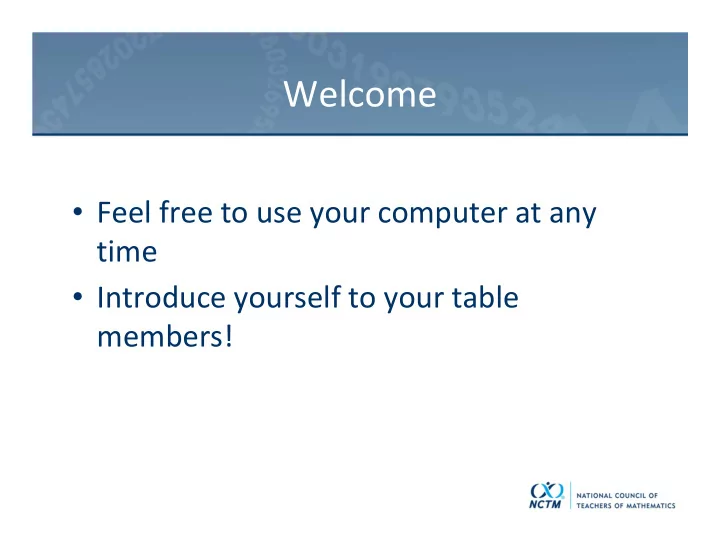

Welcome • Feel free to use your computer at any time • Introduce yourself to your table members!
Task Discussion 1: Focus on Reasoning and Explaining July 14, 2016 10:30-12:30pm
Our Geometry Sessions • In our three sessions, we will engage in guided geometry activities and facilitated discussions • We will look at: – The CCSS Standards for Mathematical Practice – NCTM Mathematics Teaching Practices • We will come together in the same group each day. • Learning vs. Doing
Our Geometry Sessions: Norms Help one another to speak. We stay aware of and contribute to the equity of voices in the room. Welcome Diversity We value and learn from our different opinions, experiences and practices. Collaboration & Relationships We are in this together. We are authentic in our questions/concerns/feedback. Bring a Growth Mindset We enter each session with a growth mindset -- open to change and to new ideas. Self Responsibility We take care of our physical, mental and emotional systems. We take what we came for.
True for You or Not Yet? 1.I’ve read the Standards of Mathematical Practice (SMPs: p.24). 2.I plan lesson activities to develop the SMPs in my students. 3.My classroom is structured in a way that promotes student discussions, including justifying and generalizing
Today’s Opening Talk • How did today’s opening talk help you better understand the SMP’s? (discuss at your table)
Reasoning and Explaining 1. Make sense of problems and persevere in solving 2. Reason abstractly and quantitatively 3. Construct viable arguments and critique the reasoning of others 4. Model with mathematics 5. Use appropriate tools strategically 6. Attend to precision 7. Look for and use structure 8. Look for and express regularity in repeated reasoning
Rotating Square Task What do you notice?
Rotating Square Task What mathematical question(s) comes to mind when making sense of this figure?
Rotating Square The congruent squares ( n units by n units) overlap as shown in the figure. Vertex C of one square is at the center of the other square.
Private Reasoning Time If the square with vertex C is allowed to rotate about the center, C , of the other square, what is the largest possible value of the overlapping shaded area? Remember, think like your students – How would they reason abstractly and quantitatively? – What arguments would they construct?
Table Talk If the square with vertex C is allowed to rotate about the center, C , of the other square, what is the largest possible value of the overlapping shaded area? Remember, think like your students – How would they reason abstractly and quantitatively? – What arguments would they construct?
Rotating Square What is true about the largest possible value of the overlapping shaded area. Justify your answer.
Rotating Square Use your chart paper to answer the following with your table: • What are mathematical questions that may arise as students are thinking about the Rotating Squares situation? • How might students approach this problem? • How would you present this task to your class?
Rotating Square What is the mathematical argument that the area of the general quadrilateral is ¼ of the area of the original non-rotating square?
Reasoning and Sense Making • SMP #2: Reason abstractly & quantitatively • SMP #3: Construct viable arguments and critique the reasoning of other Read SMP’s & Discuss connection to the task.
Rotating Square Conjecture • Let’s examine the following conjecture based on student discoveries: The area of the shaded region is always ¼ of the area of the non-rotating square with center C . • Use mathematical reasoning to convince others that this conjecture is always, sometimes, or never true.
Reasoning and Sense Making • Ranges from informal justification to formal deduction, includes inductive observation. • Conjecture • Justification • Generalization • How do you get your students engaged in each?
Reasoning and Sense Making • Ranges from informal justification to formal deduction, includes inductive observation. • Conjecture – – a generalization that isn’t justified yet • Justification – – a mathematical argument that is OR isn’t mathematically valid • Generalization – – a conjecture for which a valid math justification can be provided
Rotating Square—Extension Is this conjecture true for all pairs of squares? …other quadrilaterals?....for other regular polygons?...for circles? D
Core Mathematical Idea(s) • What are two mathematical ideas that stand out for you? Why are they salient? • What is one question that you have?
Thinking About Our Thinking Reflecting on the task and activities today: • What new ideas for supporting student mathematical reasoning are you thinking about?
Dialogue for Action: Next Steps • HW for Tonight: Reflect about our session today. Be ready to share tomorrow! – What actions will you take as a result of today? – Read the Mathematics Teaching Practices (p. 22) and reflect on how you will be implementing them in your classroom.
Recommend
More recommend